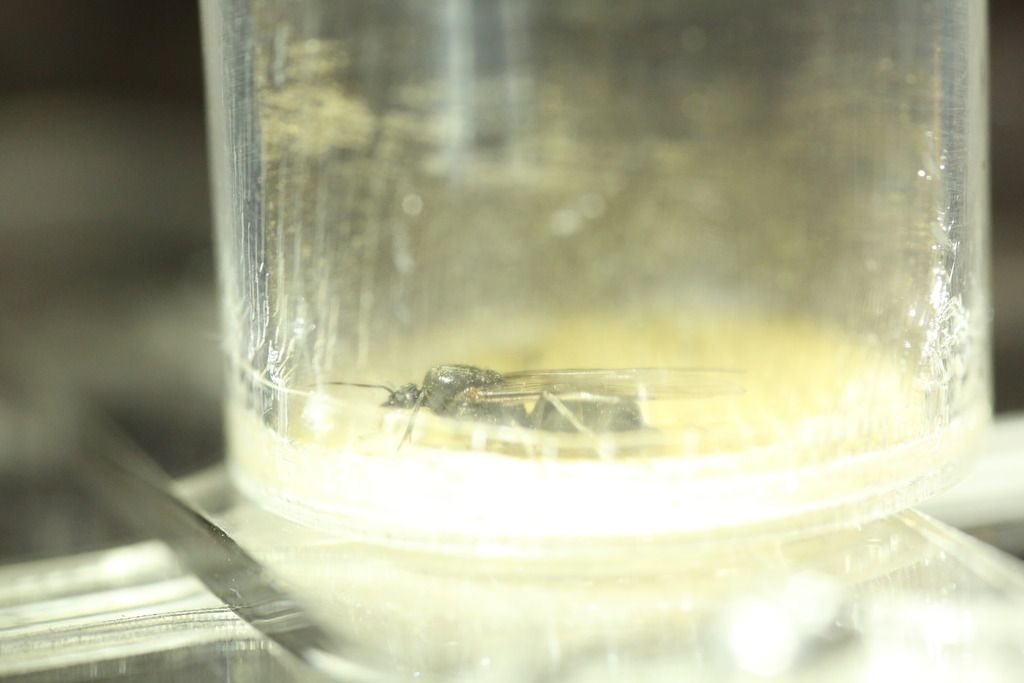- Formiculture.com
- Forums
- Gallery
- Members
- Member Map
- Chat

Queen, Simi Valley
Started By
Wamdar
, Apr 13 2015 11:48 AM

Best Answer dspdrew , April 14 2015 - 6:27 AM
This BTW was ID'd as Liometopum, most likely L. occidentale by James C. Trager on another forum.
Go to the full post
17 replies to this topic
#1
 Offline
-
Posted April 13 2015 - 11:48 AM
Offline
-
Posted April 13 2015 - 11:48 AM
Almost flew into my mouth while I was working! Much bigger than my previous queen find!
#2
 Offline
-
Posted April 13 2015 - 12:12 PM
Offline
-
Posted April 13 2015 - 12:12 PM
Look how small the head is and how large the eyes are.
If it is actually an ant, it would be a male, not a queen.
Can you get a side picture? I am kind of doubting it is actually an ant.
You may find it easier to use a 3rd party picture hosting site, as your images can be much larger. Such as Photobucket, Imgur, Flickr.
http://www.formicult...sting-pictures/
"Always do right. This will gratify some people, and astound the rest." -- Samuel Clemens
#3
 Offline
-
Posted April 13 2015 - 12:50 PM
Offline
-
Posted April 13 2015 - 12:50 PM
I am not sure if this is even a ant. As Crystal said its more likely to be a male not a queen.
#4
 Offline
-
Posted April 13 2015 - 1:39 PM
Offline
-
Posted April 13 2015 - 1:39 PM
#5
 Offline
-
Posted April 13 2015 - 2:21 PM
Offline
-
Posted April 13 2015 - 2:21 PM
#6
 Offline
-
Posted April 13 2015 - 2:22 PM
Offline
-
Posted April 13 2015 - 2:22 PM
OK, finally used the slr..thanks for all your help!
#7
 Offline
-
Posted April 13 2015 - 2:32 PM
Offline
-
Posted April 13 2015 - 2:32 PM
looks like an ant. Maybe even a queen.....
I wanna get my hands on some Campontus Pennsylvanicus or Ponera Pennsylvanica Queens!
#8
 Offline
-
Posted April 13 2015 - 4:33 PM
Offline
-
Posted April 13 2015 - 4:33 PM
That isn't a ant sorry to say. One easy way to tell is look for the elbow on the antennas.
#9
 Offline
-
Posted April 13 2015 - 5:09 PM
Offline
-
Posted April 13 2015 - 5:09 PM
I'm pretty sure that is a male ant. Remember, if it's a male, their antennae bend so close to their heads sometimes that they don't look like they even have an elbow.
#10
 Offline
-
Posted April 13 2015 - 5:30 PM
Offline
-
Posted April 13 2015 - 5:30 PM
What a great clue! thanks drew, that sealed the deal instantly as a good tell tale sign for me now on
#11
 Offline
-
Posted April 13 2015 - 6:44 PM
Offline
-
Posted April 13 2015 - 6:44 PM
Looks like a male to me. If queens flew into my mouth that would make anting so much easier! Boy I hope this doesn't get taken out of context...
- PTAntFan likes this
Camponotus vicinus, Crematogaster 1, Crematogaster 2, Formica francoeuri, *, *, Myrmecocystus testaceus, Novomessor cockerelli, Pheidole hyatti, Pogonomyrmex californicus, Pogonomyrmex rugosus, Solenopsis invicta
#12
 Offline
-
Posted April 13 2015 - 7:57 PM
Offline
-
Posted April 13 2015 - 7:57 PM
I am positive this is a Camponotus male. I have been finding them all over Simi Valley for the last few weeks.
- Trailandstreet likes this
#13
 Offline
-
Posted April 13 2015 - 8:30 PM
Offline
-
Posted April 13 2015 - 8:30 PM
I am positive this is a Camponotus male. I have been finding them all over Simi Valley for the last few weeks.
Would that be implying queens are out and about? ![]()
Camponotus vicinus, Crematogaster 1, Crematogaster 2, Formica francoeuri, *, *, Myrmecocystus testaceus, Novomessor cockerelli, Pheidole hyatti, Pogonomyrmex californicus, Pogonomyrmex rugosus, Solenopsis invicta
#14
 Offline
-
Posted April 13 2015 - 9:27 PM
Offline
-
Posted April 13 2015 - 9:27 PM
I am positive this is a Camponotus male. I have been finding them all over Simi Valley for the last few weeks.
Would that be implying queens are out and about?
Not that I know of, I find Camponotus releasing males for no reason all the time without a single female alate.
#15
 Offline
-
Posted April 14 2015 - 4:47 AM
Offline
-
Posted April 14 2015 - 4:47 AM
Good to know! Thanks!
#16
 Offline
-
Posted April 14 2015 - 6:27 AM
Best Answer
Offline
-
Posted April 14 2015 - 6:27 AM
Best Answer
#17
 Offline
-
Posted April 14 2015 - 7:52 AM
Offline
-
Posted April 14 2015 - 7:52 AM
Oh that is even better...
#18
 Offline
-
Posted April 14 2015 - 2:56 PM
Offline
-
Posted April 14 2015 - 2:56 PM
Sorry, meant to update this thread with that information!
1 user(s) are reading this topic
0 members, 1 guests, 0 anonymous users





















